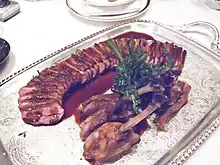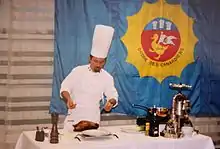Pressed duck
Pressed duck (French: Canard à la presse, Caneton à la presse, Canard à la rouennaise, Caneton à la rouennaise or Canard au sang) is a traditional French dish. The complex dish is a specialty of Rouen and its creation attributed to an innkeeper from the city of Duclair.[1] Since the 19th century,[2] it has also been a specialty of the Tour d'Argent restaurant in Paris where it is formally known as the Caneton Tour d'Argent (Tour d'Argent duckling). It consists of various parts of a duck served in a sauce of its blood and bone marrow, which is extracted by way of a press. It has been considered "the height of elegance."[3]

_2013-02-27_17.jpg.webp)
Preparation
First, a duck (preferably young and plump[4]) is asphyxiated to retain the blood. The duck is then partially roasted. Its liver is ground and seasoned, then the legs and breast are removed.

The remaining carcass (including other meat, bones, and skin) is then put in a specially-designed press, similar to a wine press. Pressure is then applied to extract duck blood and other juices from the carcass. The extract is thickened and flavoured with the duck's liver, butter, and cognac, and then combined with the breast to finish cooking.
Similar dishes
Almond pressed duck is a Cantonese dish also called pressed duck or almond duck that is not similar to French pressed duck. Blood is not used in this recipe, so the duck is slaughtered and bled as for any other regular preparation. The duck is seasoned and steamed, then deboned. The meat is then flattened, by press or rolling pin, to a uniform thickness of about 3⁄4 inch (19 mm). The pressed/rolled duck meat is steamed again, to help keep its shape; then, deep-fried just before serving. The meat can be cut into portion sizes before or after the second steaming, but should already be portion sized at the time it is deep-fried so that it can be served immediately afterward.
Cantonese pressed duck is also called Chinese pressed duck, steamed deep-fried pressed duck, and Wor Shu duck/Wor Shu Op.[6]
See also
References
- "Le canard à la rouennaise ou canard au sang". Rouentourisme.com.
- "Frédéric Delair and the Numbered Duck". La Tour d'Argent -- history. Archived from the original on 17 January 2013. Retrieved 12 January 2013.
- "Pressed Duck a la Tour d'Argent," in Tennant, Jr., S.G.B. (1999). Ducks & Geese. Willow Creek Press. p. 26. ISBN 978-1-57223-202-0.
- Tennant, Ducks & Geese, 26.
- "Pressed Duck a la Tour d'Argent," in Peterson, James (2002). Glorious French food: a fresh approach to the classics. John Wiley and Sons. p. 394. ISBN 978-0-471-44276-9.
- "Cantonese Pressed Duck". Cook's Info.